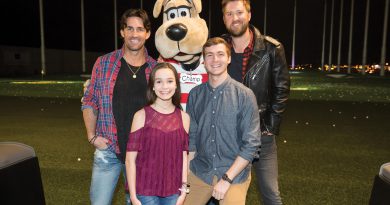All in the Family
Published on December 15th, 2011 by Diana Duren.
by Christina Echegaray

A month shy of her first birthday, Marley McIver Molder spiked a fever of 104 degrees, and was unwilling to eat and lethargic. Worried about a high white blood cell count, a sign the body is fighting illness, her Columbia, Tenn., pediatrician sent her to be admitted to a local hospital. She had a serious kidney infection.
In what was a chaotic, frightening situation for her parents, Chaz and Elizabeth Molder, there was also a sense of calm. Twelve years earlier, as a teen, Chaz Molder had been admitted to the hospital with a kidney obstruction under the care of the same community pediatrician and the same specialist at Vanderbilt.
The same smooth, comprehensive care Chaz received, and that aided him in healing, was also helping his daughter. He wasn’t worried. He was confident she would be fine.
Day after day, children and families filter through the sliding glass doors of Children’s Hospital to receive the best care for the best chance at life.
They are sent by the more than 300 community pediatricians in private practices throughout Middle Tennessee and parts of Kentucky who coordinate with and refer to the physicians and subspecialists inside Children’s Hospital for specialized care. Together they work as one.
“It’s Vanderbilt’s hospital, but it’s also the community’s hospital,” said Bob Mallard, M.D., a pediatrician at Heritage Medical Associates in Nashville. “It is a resource without peers. It’s the only resource that most of us use for taking care of kids.”
The Children’s Hospital has long been “more than a place,” a refrain of David Karzon, M.D., a beloved former chair of the Department of Pediatrics at Vanderbilt and champion of child health.
During interviews in the early 1970s, Karzon spoke about his view of pediatric health care. His words perhaps reflect best on the region’s care for children: “The Children’s Hospital is not bricks and mortar, it is a way of approaching children’s medical needs.”

Indeed, it was Karzon who, upon arriving in Nashville in 1968 to become chair of Pediatrics at Vanderbilt, held a gathering for all community physicians at his home. There, he invited all interested pediatricians to have privileges to directly admit and check up on their patients. The offer was a welcome departure from old rules, under which only select community pediatricians were given rights.
He knew providing the best care would require a community of doctors dedicated to the same cause regardless of practice setting or specialty: helping children get well and saving lives.
Karzon’s bold move would set up a vital community partnership for years to come that would ensure care for children and also prepare the next generation of pediatricians. As Children’s Hospital nears completion of a 33-bed, acute care expansion, that partnership is just as relevant and important as it was more than 40 years ago.
“In every regard, we value our community pediatricians and we cannot do our job without them,” said John W. Brock III, M.D., Monroe Carell Jr. Chair, surgeon-in-chief of Children’s Hospital and director of the Division of Pediatric Urology. “We are committed, and this partnership is integral to the quality health care of our children.”
Twelve Years Earlier
Chaz Molder, a 28-year-old lawyer from Columbia, Tenn., remembers the searing pain he felt in his right flank, an area just below the ribs, when he was 15. As a typical teenager, he dismissed it as sports related, not alerting his parents. But one night, when the pain got too severe, he ended up in the Emergency Department at Maury Regional Medical Center in Columbia. His local pediatrician, Carol Broadway, M.D., F.A.A.P., from Columbia Pediatrics, helped diagnose Molder with ureteropelvic junction obstruction (UPJ), a blockage that prevents urine from moving between the kidney and bladder.
Broadway referred Molder to Brock at Children’s Hospital, then known as Vanderbilt Children’s Hospital.
“During one of my emergency visits to Vanderbilt, I recall laying in the hospital bed, just prior to Dr. Brock inserting my stent (a tiny tube used to open a pathway), literally thinking I was going to die,” said Molder. “I remember Dr. Brock telling me, ‘it was going to be OK,’ and when I woke up, the pain had subsided.”
Molder had two major reconstruction surgeries and multiple stents put in place under Brock’s care at Children’s Hospital until he was cleared when he was 19.
“I feel certain that the reason I have healthy and functioning kidneys today is primarily due to the interplay between Maury Regional Medical Center and Vanderbilt, specifically, the relationship between Dr. Broadway and Dr. Brock,” Molder said.
When Marley “Mac,” as she is known to family, was born June 18, 2010, his first question was if she had working kidneys. She did. But almost a year later during a vacation to Palm Beach, Fla., Marley got an infection that sent her down the same path as her father.
“I knew that Marley would receive the same care at Vanderbilt as I had received just 12 years ago.”
Part of the Team
Every day, private practice pediatricians refer patients to Children’s Hospital for a range of issues, from the most complicated, sometimes life-threatening childhood illnesses to broken bones, and everything in between. Doctors provide the highest level of neonatal intensive care in the state, and the hospital has the only Pediatric Emergency Department in Middle Tennessee. Also, physician-scientists continue to search endlessly for better treatments and cures for cancer, prematurity, cardiology, diabetes and more.
“All of the subspecialties, everything you would need to take care of a child over the routine is at Vanderbilt,” said William Moore, M.D., president of Premier Medical Group in Clarksville, Tenn. “It’s more of a partnership in care, more than it is a relationship. I look at Vanderbilt as an extension of my office.”
Pediatricians are able to access their patient’s information through secure, online health records. If a patient goes to the emergency department or is admitted, an email is sent to the community physician about the patient. Community physicians may also round at the hospital on the patients under their primary care.
“To facilitate the daily interactions around care for mutual patients, we have created infrastructure to ensure that our community pediatric partners feel they are a part of our team,” said Meg Rush, M.D., acting chair of the Department of Pediatrics and chief of staff of the hospital. To be granted privileges at Children’s Hospital, pediatricians apply for credentials.
“We have ancillary privileges and can access the system to see lab results right away, read consults,” said Carol Broadway, M.D., who has practiced at Columbia Pediatrics since 1992. “If I send a child for an MRI or an echocardiogram, I can look it up right away. It saves a lot of time and makes care for patients more seamless.”
When possible, doctors at Children’s Hospital communicate with community pediatricians by phone or in person, something they both wish they could improve on. That’s not always easy in an age of expanding use of technology.
“You develop relationships with people,” said Broadway. “You know the competency of the people up there. I will call and check on patients. As long as I’ve been doing this, I know the assistants by name.”
A Special Place
It’s those kinds of relationships that comforted the Molders during Marley’s kidney infection. About six months ago, upon the family’s return from vacation, Broadway sent Marley to Children’s Hospital for several tests. She was diagnosed with pyelonephritis, an infection of the kidney. All tests ruled out an obstruction or anatomical issue. She healed as her father did, able to go home to enjoy her 2-year-old dog, a black lab named Knox, and blow her trademark kisses at friends and family. In September, Marley, at 15 months old, was cleared and released from the care of Brock at a urology visit.

“I am a lucky guy,” said Molder. “And, although she might not realize it yet, my daughter is a lucky girl to have the accessibility to such fine medical treatment.”
Together, Children’s Hospital, a teaching institution, and community physicians are helping to prepare the next generation of physicians to work in hospitals and private practices.
“This is one of the very unique aspects about our long-standing relationship with the community pediatricians – they are part of our teaching faculty,” said Rush.
Each year, Vanderbilt’s pediatric residents are given the opportunity to do a clinical rotation practicing outside the hospital in a private practice. It is an invaluable experience that creates a well-rounded physician. The community physicians welcome them into their offices eager to show them another side of medicine. Community pediatricians are also invited to participate as a ‘community ward attending’ on one of the resident inpatient teams.
“It is good to get out into the community and see how care is run from that perspective,” said Moore. “It broadens their knowledge base. You get a different interaction with families. You get to watch the children grow up and change rather than see them just for acute illnesses in the hospital.”
Since Karzon’s era, children’s health care at Vanderbilt has only continued to grow. In 2004, the community helped build Middle Tennessee’s first freestanding children’s hospital. With more space, more children had access to the medical care they needed and deserved.
Young patients moved from the three pediatric floors within the adult hospital to an eight-floor, 616,000-square-foot building. Pediatric clinics spread among several buildings on the Vanderbilt University Medical Center campus moved into the 11-story Doctor’s Office Tower. The number of private practice physicians also had grown from about 25-30 in the late 1970s to hundreds.
Children’s Hospital is entering its next era of continuing state-of-the-art, quality medical care. In 2012, a five-story, 30,000-square-foot addition will open at the hospital, adding an additional 33 acute-care beds to the already existing 243 beds. Ushering the community’s quality care of children into the future will be a timeless, unique partnership.
“We’re one faculty,” said Brock. “We want this to continue to be a special place as it always has been, offering the highest quality care possible for our children.”
“I knew she was in good hands,” said Molder.
Quality health care for children in Tennessee, and well beyond, has always been deeply rooted in the region’s community. It isn’t in one place. It isn’t one person. It’s born out of a unique partnership that has spanned decades.


